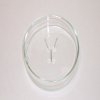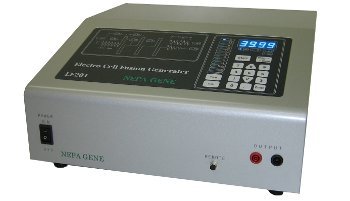|
Search by product code, name or application:
|
|
|
Search for the most appropriate electrode by research application:
|
|

Product Code: SONIDEL STK10
| | Desc: | Ultrasound Transfection Positive Control |
| Applic: | Sonoporation Transfection Kit |
|
|

Product Code: CUY5000P1 - For Nuclear Fusion
|
Application:
Electrodes for Electro Cell Fusion |
Description:
Platinum wire electrodes on petridish, 1mm gap |
|
|
» » » »
LF201 - Electro Cell Fusion Generator Applications - ES/EG Cell and T-Cell (Activation or Reprogramming of
Pluripotent Stem Cell) - Human Dendtritic and Tumor Cells (Cancer Vaccine)
- Yeast and Mold
- Islet Cells and Tumor Cells (Transplantation of Insulin-Secreting Cell)
- Spleen and Myeloma cell fusion (ELISA)

| - Plant Protoplast Fusion
- Human Monoclonal Antibody production
(Treatment of Breast Cancer with Anti-Cancer Drug) - Electrofusion of Recipient Oocyte and Somatic Cells
(Bovine, Pig, Mouse and Rabbit Cloning) - Electrofusion of Hamster or Mouse 2-Cell Blastomeres
(Tetraploid Embryo)
Cell Fusion Nuclear Transfer (Cloning) Oocyte Activation |
Electro Cell Fusion Advantages v PEG
- Greater control on the fusion
- Double/triple efficiency compared with PEG
- Electro cell fusion results are more stable
- No Toxicity
- Reproducibility not dependant on Researcher Skill
| Features | | Increased Reproducibility To ensure accurate and reproducible cell fusion it is essential to align the
target cells prior to the fusion event. If the ion concentration of the buffer
is too high, ions will cause a water stream which will disturb the cell
alignment (pearl chain). Uniquely, the LF201 enables the researcher to
measure the resistance of the buffer prior to cell fusion and ensure the
correct ion concentration for exact cell alignment (in all experiments).
This greatly enhances reproducibility. AC / DC Switching Time The AC current is used to make a pearl chain (line of cells). For effective
cell fusion, it is imperative that the DC pulse is applied immediately after
the AC pulse and when the target cells are still actually in physical contact.
With the LF201, the switching time from AC pulse to DC pulse is
less than 5Ásec. Two Kinds of DC Pulse Outputs The LF201 offers two possible DC pulse modes. A positive (+) square wave
or a bipolar (+/-) square wave. The first is a single direction pulse and in
the other the pole of the DC pulse is switched to the opposite polarity
during pulse delivery. | Post Fusion There are two different types of post fusion AC current. One, a standard
Sine Wave (constant amplitude). The other, a Fade Wave (gradually
decreasing amplitude). DC Pulse Output The LF201 allows the researcher to output the DC pulse either
automatically or manually. The automatic output mode facilitates routine
work. The manual output mode enables the researcher to apply a DC
pulse while using a microscope - this is particularly useful when working
with unfamiliar cells and during nuclear transplantation. PC Interfacing The LF201 can be controlled via Microsoft Windows compatible software
where a cell fusion program can be entered and edited through a PC.
Each program can generate a text file capturing details such as experiment
time/date, resistance data etc.. Ease of Operation For ease of operation, each cell fusion parameter is displayed on its own
individual LED. |
Specifications AC Pulse | Wave Shape
Voltage Frequency Duration Post Fusion AC Mode Shunt Resistor Resistance Measurement AC/DC Switching Time Memory | | Sine Wave
0-75Vrms, 1V resolution 1MHz Pre-Fusion: 0-100sec (1sec resolution) Post-Fusion: 0-10sec (1sec resolution) Sine or Fade Wave* Greater than 50Ω
Up to 39.99kΩ Less than 5Ás 99 protocols |
DC Pulse | Wave Shape
Voltage Pulse Length Pulse Interval Number of Pulses Output Weight Power Dimensions | | Normal Mode: positive (+) Square Wave Pulse
Bipolarity Mode: Bipolar (+/-) Square Wave Pulse 0-1200V (1V resolution) 0-100Ás (1Ásec resolution) 0.1-10sec (0.1sec resolution) 1-100 Automatic or Manual 9kg 100V-240V 375W x 360D x 170H mm |
* In normal mode, AC amplitude is constant. In fade-out mode, AC amplitude decreases. Applications and Electrode Selection : Cell Fusion 
Nuclear Transfer (Cloning) and Oocyte Activation 
|
|